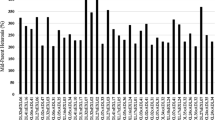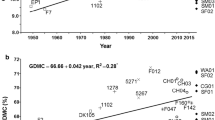Abstract
Genetic improvement of popular elite single cross hybrids (SCHs) is considered as the most economical and fast-track approach to enhance the productivity of hybrids in crops including maize. This approach requires improvement of parents (I1 and I2) of elite SCHs. This in turn requires apriori identification of donor inbred lines (Id) containing favorable dominant alleles not present in I1 and I2 of elite SCHs. Under these premises, we evaluated test cross (TC) hybrids derived from crossing 11 putative inbred lines with parents of three elite SCHs for grain yield across five temporal and spatial environments. Based on the four predictor statistics namely relative number of favourable alleles present only in Id (μG'), minimum upper bound on μG (UBND), Net improvement (NI) and Probability of net gain of favourable allele (PNGg) estimated based on the grain yield of TC hybrids, we identified three best Id for improvement of ‘Hema’, ‘Nithyashree’ and ‘MAH 4–5’ hybrids. Using the relationship estimators, we identified that seed parent of ‘Hema’, and pollen parents of ‘Nithyashree’ and ‘MAH 14–5’ are to be improved. Further, we could also find that the number of favourable dominant alleles in Id were far more than those in any parent of ‘Hema’ and ‘Nithyashree’. On the contrary, three tested Id were comparable to parents of ‘MAH 14–5’. Based on these results we predicted that it is desirable to develop improved versions of parents of ‘Hema’ and ‘Nithyashree’ and those of ‘MAH 14–5’ from backcross and F2 populations, respectively. We have also proposed breeding pipeline for improvement of parents of the three elite SCHs.
Similar content being viewed by others
Data availability
Not applicable.
Code availability
Not applicable.
References
Alvarado G, Rodríguez FM, Pacheco A, Burgueño J, Crossa J, Vargas M, Paulino P, Lopez-Cruz MA (2020) META-R: a software to analyze data from multi-environment plant breeding trials. The Crop J 8(5):745–756
Balakrishna B, Reddy VC, Reddy KVS, Satish Y, Reddy KB (2018) Identification of donor parents containing favourable alleles for improving target American cotton hybrid (NA 1325 × L 604). Indian J Agric Sci 88(3):504–508
Bernardo R (1990) An alternative statistic for identifying lines useful for improving parents of an elite single cross. Theor Appl Genet 80:105–109
Bernardo R (2020) Breeding for quantitative traits in plants, 3rd edn. Stemma Press, Woodbury, Minnesota, USA
Bernardo R (2023) Essentials of plant breeding, 2nd edn. Stemma Press, Woodbury, Minnesota, USA
Chahal GS, Gosal SS (2002) Principles and procedures of plant breeding. Biotechnology and Conventional Approaches. Alpha Science International, UK, 604
Dudley JW (1984) A method of identifying lines for use in improving parents of a single cross. Crop Sci 24:355–357
Dudley JW (1987) Modification of methods for identifying inbred lines useful for improving parents of elite single crosses. Crop Sci 27:944–947
Duvick DN, Smith JSC, Cooper M (2004) Changes in performance, parentage, and genetic diversity of successful corn hybrids, 1930–2000. In: Corn: Origin, History, and Production, C. W. Smith, J. Betran, and E. C. A/Runge, (ed). pp 65–97. Wiley, Hoboken, Rung NJ
Eathington SR, Crosbie TM, Edwards MD, Reiter RS, Bull JK (2007) Molecular markers in a commercial breeding program. Crop Sci 47(S3):S154–S163
Falk DE (2010) Generating and maintaining diversity at the elite level in crop breeding. Genome 53:982–991
Gerloff JE, Smith OS (1988a) Choice of method for identifying Germplasm with superior alleles 1. Theoretical Results Theor Appl Genet 76:209–216
Gerloff JE, Smith OS (1988b) Choice of method for identifying germplasm with superior alleles. II. Computer Simulation Results Theor Appl Genet 76:217–227
Hallauer AR (1990) Methods used in developing maize inbred lines. Maydica 35:1–16
Hallauer AR, Carena MJ, Miranda Filho JD (2010) Quantitative genetics in maize breeding, Handbook of plant breeding 6, Springer Science+Business Media. LLC. https://doi.org/10.1007/978-1-4419-0766-0_7
Kempthorne (1957) An introduction to genetic statistics. John Wiley and Sons Inc, New York
Kumar MN, Venkatesh S, Satyanarayana E (2003) Comparison of methods to identify donor inbreds with favourable alleles for the improvement of elite maize single cross hybrids. Indian J Genet Plant Breed 63(03):212–214
Liu J, Fernie AR, Yan J (2019) The past, present and future of maize improvement: domestication, genomics and functional genomic routes toward crop enhancement. Plant Comm 1:1–19
Mackay IJ, Cockram JC, Howell P, Powell W (2020) Understanding the classics: the unifying concepts of transgressive segregation, inbreeding depression and heterosis and their central relevance for crop breeding. Plant Biotechnol J 19:26–34
Malvar RA, Revilla P, Cartea ME, Ordas A (1997) Identification of field corn inbreds adapted to Europe to improve agronomic performance of sweet corn hybrids. Crop Sci 37:1134–1141
Massman JM, Jumg HJG, Bernardo R (2013) Genome wide selection versus marker-assisted recurrent selection to improve grain yield and stover quality traits for cellulosic ethanol in maize. Crop Sci 53:58–66
Metz G (1994) Probability of net gain of favorable alleles for improving an elite single cross. Crop Sci 34(3):668–672
Paramesh M, Reddy KHP, Reddy DM, Rajarajeswari V, Bhaskara-Reddy BV (2018) Identification of favourable alleles in donor inbreds for improvement of single cross hybrid of maize (Zea mays L.). Int J Pure App Biosci 6(5):521–526
Pfarr DG, Lamkey KR (1992) Comparison of methods for identifying populations for genetic improvement of maize hybrids. Crop Sci 32:670–677
Reddy DM, Ahuja VP, Mukherjee BK (2003) Identification of favourable alleles in inbred parents for the improvement of single cross hybrid in maize (Zea mays L.). Indian J Genet Plant Breed 63(03):253–254
Reddy DM, Ahuja VP, Mukherjee BK (2005) Comparison of various statistics for identification of maize inbreds with favourable alleles useful for the improvement of single cross hybrid in maize (Zea mays L.). Indian J Genet Plant Breed 65(04):253–256
Revilla P, Malvar RA, Cartea ME, Ordas A (1998) Identifying open pollinated populations of field corn as sources of cold tolerance for improving sweet corn. Euphytica 101:239–247
Sabitha N, Reddy DM, Kumar MH, Reddy DL, Reddy BR (2021) Identification of favourable alleles for genetic improvement of selected single cross hybrid of maize (Zea mays L.). J Pharm Innov 10(8):779–783
Suryanarayana L, Reddi-Sekhar M, Ratna-Babu D, Ramana AV (2018) Identification of donor lines containing favourable alleles for improving target maize hybrid (BML 6 × BML 7). J Pharm Innov 7(7):512–514
Zanoni U, Dudley J (1989) Comparison of different methods of identifying inbreds useful for incorporating elite maize hybrids. Crop Sci 29:577–582
Acknowledgements
We acknowledge CIMMYT, Mexico for sharing inbred lines constituting experimental material of our study. We also acknowledge the Corteva Agriscience, Bangalore, India for providing facility for evaluating the experimental material. The senior author gratefully acknowledges Council of Scientific and Industrial Research (CSIR), New Delhi, India for providing Junior Research Fellowship (JRF) vide No. 09/0271(12086)/2021-EMR-1 dated 01-05-2021 for pursuing PhD degree program at University of Agricultural Sciences, Bangalore, India.
Author information
Authors and Affiliations
Corresponding author
Ethics declarations
Conflict of interest
Author of this manuscript declare that we have no conflict of interest.
Consent for publication
All the authors have provided the consent for publication of this manuscript.
Ethical approval
This manuscript does not contain studies performed by any of the authors involving human or animals.
Additional information
Publisher's Note
Springer Nature remains neutral with regard to jurisdictional claims in published maps and institutional affiliations.
Supplementary Information
Below is the link to the electronic supplementary material.
Rights and permissions
Springer Nature or its licensor (e.g. a society or other partner) holds exclusive rights to this article under a publishing agreement with the author(s) or other rightsholder(s); author self-archiving of the accepted manuscript version of this article is solely governed by the terms of such publishing agreement and applicable law.
About this article
Cite this article
Siddu, C.B., Ramesh, S., Kalpana, M.P. et al. Identification of inbred lines harbouring favourable dominant alleles not present in the parents of three elite maize (Zea mays L.) single cross hybrids. Genet Resour Crop Evol 71, 851–862 (2024). https://doi.org/10.1007/s10722-023-01666-w
Received:
Accepted:
Published:
Issue Date:
DOI: https://doi.org/10.1007/s10722-023-01666-w




